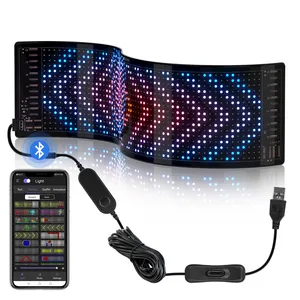
All categories
Featured selections
Trade Assurance
Buyer Central
Help Center
Get the app
Become a supplier

(116 products available)













































The WS2801 Arduino matrix LED pixel consists of different types of LED pixel matrices. Each type has unique features and specifications that make the pixel flexible for different applications. The types include;
RGB LED Matrix Pixel
The RGB LED pixel matrix is a lighting system composed of multiple pixels arranged in a grid. Each pixel consists of red, green, and blue LEDs. The RGB LED pixel matrix can be controlled to produce various colors and effects. It is commonly used in displays, decorative lights, and backlighting.
RGBW LED Pixel Matrix
The RGBW LED pixel matrix enhances the color mixing capability by adding a white LED to each pixel. The white LED produces bright and clean white light. The RGBW LED pixel matrix is used in applications that require vibrant colors and high-intensity white light. Examples of such applications include stage lighting and architectural lighting.
Reed RGB LED Matrix
The Reed RGB LED matrix is a lighting grid that uses reed RGB LEDs. The Reed RGB LED is characterized by its higher brightness and better color consistency compared to standard RGB LEDs. The Reed RGB LED matrix is suitable for large displays and installations where uniform brightness is needed across the entire matrix.
Monochrome LED Matrix
The monochrome LED matrix consists of pixels with either red, green, or blue LEDs. It is used for simple displays that show text and graphics in a single color. The monochrome LED matrix is widely used in applications where color is not needed. For instance, it can be used in scoreboards and information displays.
Addressable LED Matrix
The addressable LED matrix is a lighting grid made up of addressable LEDs. Each LED can be controlled independently. This allows for dynamic lighting effects and patterns. The addressable LED matrix is popular in artistic installations and custom lighting projects due to its flexibility and creativity.
Here are the features and functions of the WS2801 pixel matrix that make it a popular choice among consumers.
Arduino LED Matrix:
This LED matrix has 8 rows and 32 columns, making it a total of 256 pixels. Each pixel can display its own color and brightness, allowing for detailed images and animations. The LED ws2801 can be controlled using an Arduino board. The Arduino can send data to the LED matrix to control which lights up and what color they are. This makes it easy to create custom displays and control the LED matrix with sensors or other inputs.
Data Protocol:
The WS2801 pixel matrix uses a specific data protocol to control the LEDs. This protocol allows for fast communication between the Arduino and the LED matrix. It also ensures that the lights are controlled in the correct order, which is important for a matrix display. The WS2801 is designed to be daisy-chained. This means multiple matrices can be connected and controlled using just one Arduino board.
Color and Brightness:
This LED matrix can display many colors and brightness levels. Each pixel is made up of three LEDs: red, green, and blue (RGB). By changing the brightness of each color LED, different colors can be made. The brightness of the LEDs can also be adjusted to make the display brighter or dimmer.
Power Supply:
The WS2801 pixel matrix requires a power supply to light up. The power supply needs to provide enough current for all the pixels. Each pixel can draw a lot of power, especially when it is bright. The power supply voltage also needs to be correct. The WS2801 pixels usually run on 5 volts. If the voltage is too high or too low, the LEDs could be damaged.
Customizable Display:
One of the best features of this pixel matrix is that it can be customized to display anything. Static images and dynamic animations can be displayed. The brightness and color can also be customized. The size of the matrix can be increased by connecting more matrices. This allows for larger displays.
The WS2801 LED pixel can be used in various scenarios, including:
Lighting displays for events and concerts:
These LED pixels are commonly used in events and concerts lighting displays. They can create a dynamic and colorful lighting effect that enhances the events ambience and atmosphere. The LED pixel lights can be programmed to change colors and patterns in sync with music during concerts.
Architectural lighting:
WS2801 LED pixel lights can be installed on building facades to offer decorative lighting. They create attractive lighting effects on the building for increased aesthetics. Also, these lights can be used on outdoor features, such as bridges and trees, for illumination and decoration.
Advertising displays:
The pixel lights are used in LED video walls and banners to create bright and colorful advertisements. The lighting displays are eye-catching and attract more viewers. Also, these lights can be customized to display logos, texts, and animations.
Stage lighting:
These LED lights are suitable for stage lighting in theaters and live performances. They produce lights that change colors and patterns to enhance the performances. In addition, the lights can be used as backdrop lighting or accent lighting.
Decorative lighting:
WS2801 LED pixel lights are commonly used for decorative lighting during festive seasons. For instance, they can be used to illuminate Christmas and Halloween displays. Also, these lights can be installed on party and wedding decorations. More importantly, they create dynamic lighting effects on the decorations.
Custom lighting solutions:
The pixel lights can be used in various custom lighting solutions. Users can create their own lights for different applications since they are programmable. For instance, they can be used in cosplay costumes for illumination. They can also be used in DIY projects for decorative and functional lighting.
Backlighting:
The WS2801 LED pixels can be used as backlighting on translucent surfaces. For example, they can be installed on acrylic panels or fabric. The lights create even illumination that enhances the visibility of graphics, signs, and displays.
Consider the following when choosing an LED pixel matrix:
Determine the Purpose and Scale
Decide the pixel matrix's intended use, such as art installations, light displays, visual advertising, or information displays. The matrix's size should also be considered depending on the available space and the desired resolution and impact. Larger matrices yield higher resolution displays, while smaller matrices are more manageable and cost-effective.
Consider the Pixel Count and Configuration
When choosing a pixel matrix, consider the number of pixels since this directly impacts the resolution and detail of the display. Higher pixel counts provide better image clarity and definition. The configuration of the pixels also matters, with common setups being in rows and columns forming a rectangular or square matrix.
Evaluate the LED Type and Color
The choice of LEDs significantly impacts the pixel matrix's performance and visual quality. For vibrant and dynamic displays, consider LED types with rich colors and high brightness. Additionally, the color configuration should also be considered, especially for full-color matrices that utilize RGB LEDs to produce various hues and shades.
Check the Control System
Look for a matrix with a compatible and user-friendly control system. This is important for proper functionality and ease of operation. Evaluate the control options available, such as simple controllers for basic displays and advanced systems for intricate control and programming of large matrices.
Look at the Power Requirements and Supply
The pixel matrix's power needs must be assessed to ensure sufficient power supply for optimal operation. This involves looking at the power consumption of different configurations and sizes. Also, consider the power supply options, ensuring reliable and consistent power to avoid display interruptions.
Assess Durability and Build Quality
The durability and construction quality of the LED pixel matrix must be evaluated to ensure it lasts. This is particularly important for outdoor matrices exposed to various weather conditions. High-quality materials and excellent workmanship guarantee reliable performance and consistent display.
Review Flexibility and Scalability
The pixel matrix must have flexibility and scalability so it can adapt to changing needs and demands. This involves considering modular matrices that allow the addition or removal of pixels to change the size and resolution. A flexible matrix accommodates various designs and display requirements.
Q: What are pixel LED lights?
A: Pixel LED lights are lighting systems that incorporate individually controllable RGB (red, green, and blue) LEDs. Each LED functions as a ''pixel,'' allowing for customized colors and effects. These lights are commonly used in elaborate displays, signage, and decorative lighting.
Q: How does an LED pixel work?
A: An LED pixel operates by controlling individual RGB LEDs through a controller. Each pixel's color and brightness are adjusted by sending specific signals, enabling the creation of detailed images and dynamic colors.
Q: What does a matrix on LED mean?
A: A matrix on LED refers to an arrangement of LEDs in rows and columns. This setup allows for systematic organization and control of each LED, facilitating the display of patterns, texts, images, and more.
Q: What does LED stand for?
A: LED stands for Light Emitting Diode. These are semiconductor devices that produce light when an electric current passes through them. They are known for their efficiency and long-lasting capabilities.
Q: What are the advantages of LED matrix pixel lights?
A: The advantages include high brightness and vibrant colors, low power consumption, long lifespan, flexibility in shaping and sizing, and the ability to create dynamic and programmable displays. They also offer individual pixel control, which enhances display creativity and customization.